Collar (order)
A collar, also known as collar of an order, is an ornate chain, often made of gold and enamel, and set with precious stones, which is worn about the neck as a symbol of membership in various chivalric orders. It is a particular form of the livery collar, the grandest form of the widespread phenomenon of livery in the Middle Ages and Early Modern Period. Orders which have several grades often reserve the collar for the highest grade (usually called the Grand Cross). The links of the chain are usually composed of symbols of the order, and the badge (also called "decoration", "cross" or "jewel") of the order normally hangs down in front. Sometimes the badge is referred to by what is depicted on it; for instance, the badge that hangs from the chain of the Order of the Garter is referred to as "the George".
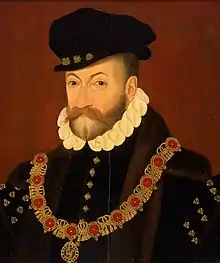
.jpg.webp)
History
A medieval tradition: the Order of the Collar (14th century)
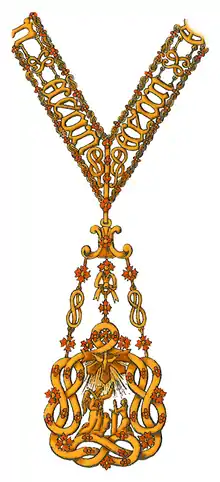
The first of the Orders of Knighthood were the military orders of crusaders who used red, green or black crosses of velvet on their mantles, to distinguish their brotherhoods. Later the members of knightly orders used rings, embroidered dragons and even garters as the symbol of their order. In the late Middle Ages the knights wore their insignia ever more prominently and medaillons, crosses and jewels in the shape of animals began to be worn on chains around the neck, known as livery collars.
In the fourteenth century, Amadeus VI, Count of Savoy (1343–1383) instituted the Order of the Collar.[1] The order was dedicated to the Blessed Virgin Mary[1] The primary and oldest insignia of the order is its collar. It consists of a solid gold medallion of the collar, which portrays the Annunciation of the Blessed Virgin Mary by the Archangel Gabriel. The medallion is surrounded by three intertwined Savoyan knots, decorated with small crosses fleury, and in the upper center, between two of the Savoyan knots, a cluster of rays with a dove, representing the Holy Spirit, is depicted also in gold.
Animated by a similar Marian devotion, the fashion of these collars spread at the same time as the fashion of wearing rosaries as necklaces spread across Europe reaching England in the fifteenth century.[2]

The Collar of the Golden Fleece (15th tradition)
Collars of various devices are worn by the knights of some of the European orders of knighthood. The custom was begun by Philip III, Duke of Burgundy, who gave his Knights of the Golden Fleece badges depicting a golden fleece: it was composed of "gold filigree plaques, simulated black and white enamel firestones, and golden fleece pendant".[3]
A French connection: the collar of Saint Michael created in 1469
Following this new fashion, Louis XI of France, when instituting his Order of St. Michael in 1469, gave the knights collars composed of scallop shells linked on a chain, most famously honouring Raoul de Lannoy after the siege of Quesnoy.[4] The chain was doubled by Charles VIII. The first official portrait of a King of France wearing the collar of the order was that of King Louis XII in 1514 and since then, all other Kings have followed that tradition until the order lapsed in 1830;[5] the Order of Liberation claimed to be its continuation in 1945 and it had its own grand collar made by master goldsmith Gilbert Poillerat,[6] which President Charles de Gaulle wore on his official portrait, preferring its Cross of Lorraine to the symbols attached to the Grand Collier of the Legion of Honour.[7]
While the order of Saint Michael was exclusively male, Queen Anne of Austria with the help of her chaplain French Dominican friar François Arnoul established the Order of the Celestial Collar of the Sacred Rosary in 1647, proving once again the connection between the collar and the rosary as an instrument of devotion. The statues of the new order were associated to instructions for fifty devout maidens and all virtuous souls, in order to renew Marian devotion and encourage the holiness of women active in the Catholic Church in France.[8]
A tradition spreading to England: Henry VIII and the collar of the Garter (16th century)

Until the reign of Henry VIII, the Order of the Garter, like most ancient of the great knightly orders, had no collar. But the Tudor king wished to match the continental sovereigns in all things as described in the statues signed on January 5, 1508, by the Register of the Order, and sent to the Holy Roman Emperor Maximilian. The present collar of the Garter knights, with its golden knots and its buckled garters enclosing white roses set on red roses, has its origin in the Tudor age. In 1672, British antiquary Elias Ashmole, described a change from the original collar worn prescribed by King Henry VIII for the collar of the Order of the Garter said to be "a gold collar, coupled together by several pieces of links in fashion of garters, with a vermillion rose, and the image of Saint George hung thereat".[9] Most of the British orders of knighthood now have collars and they are still worn on special occasions, known as collar days. The Distinguished Service Order, the Order of Merit, the Order of the Companions of Honour and the Imperial Service Order are the exceptions.
Heyday of Grand collars in the 18th century
After the 17th century the heyday of the collar was over. They were worn only on ceremonial occasions and replaced in daily life by stars pinned to the breast, and badges suspended from ribbons. Many orders retained their collars and when orders were divided into several ranks or grades the collar was usually reserved for the highest rank. The notable exception is Portugal.
At the end of the 18th century most of the European orders had only one rank; that of Knight and although they usually had collars, the cross or badge was now worn on a ribbon around the neck or over the right shoulder. When the orders became more democratic several ranks were introduced and only the highest grade, the "Grand Commanders" or "Grand Crosses", wore collars. The Netherlands never had collars but several Belgian, most of the Austrian and Prussian orders, and several Portuguese orders had collars. In Portugal all the members of these orders of knighthood wear a collar but the collars of the Grand Cross are more elaborate.
The Grand Collier de la Légion d'Honneur
Since the beginning of the 19th century, the collar has been used as the insignia of office of the Grand Master of the order. Napoleon I introduced the Grand aigle (Grand Eagle) to replace the Grand Cross as the highest rank in his Legion of Honour. Napoleon dispensed 15 such golden collars of the Legion among his kinsmen and the highest of his ministers. This collar did not survive his downfall and was abolished in 1815. He also introduced the Grand Collier de la Légion d'Honneur which was the first Grand Collar worn outside of a religious order. The President of France wears the collar of the Order of the Legion of Honour. Nowadays, the collar is often a rank above that of a Grand Cross and it is reserved for the president and foreign heads of state as it is in Brazil.
Heraldry

In heraldry, most members of orders are permitted to display the collar of their order on their coat of arms (if they are in fact entitled to wear the collar). There are often very strict rules as to how exactly the collar is to be displayed. Normally it will entirely encircle the escutcheon (shield), or the collar may be partially hidden by it. Sometimes, only a part of the collar and the badge will extend below the escutcheon.
Collars of different orders are often depicted in the heraldic achievement of various monarchs, encircling the escutcheon. Though the standard achievement used most often may depict specific collars, this does not preclude the use of or substitution with other collars to which someone may be entitled to. Some achievements depict multiple collars while others depict only one; The coat of arms of the Norwegian monarch only depicts the collar of the Order of St. Olav encircling the shield while that of Denmark's depicts the collars of the nation's two chivalric orders: the Order of the Elephant and the Order of Dannebrog. In the greater arms of Sweden, the collar of the Order of Seraphim is used. The collar of the Order of Leopold is also depicted in the national arms of Belgium.
Death of a recipient
When a member of an order dies, they are not usually buried with the collar, but it may be displayed on a pillow placed on the coffin (along with other decorations that the member may have) during the funeral. Many orders require that after the death of a member of the order, the collar and perhaps other insignia be returned to the issuing authority. Often, the requirement is that a male relative personally return the award to the order.
Orders with Collar as a separate (highest) rank
Many orders also do have a chain as an ornament that is worn at more official ceremonial occasions (worn by knights of a single class order or members of the highest class of a multi-class order). However, in some orders Collar is a separate rank above that of Grand Cross, i.e.:
Europe
 Andorra: Collar of the Order of Charlemagne
Andorra: Collar of the Order of Charlemagne Bulgaria:
Bulgaria:
 House of Saxe-Coburg and Gotha: Grand and Lesser Chain of the Order of St. Alexander
House of Saxe-Coburg and Gotha: Grand and Lesser Chain of the Order of St. Alexander
 Czech Republic: First Class with Collar of the Order of the White Lion (Recipients)
Czech Republic: First Class with Collar of the Order of the White Lion (Recipients) Cyprus: Grand Collar of the Order of Makarios III
Cyprus: Grand Collar of the Order of Makarios III Estonia: Collar of the Order of the Cross of Terra Mariana (Recipients)
Estonia: Collar of the Order of the Cross of Terra Mariana (Recipients) Estonia: Collar of the Order of the White Star
Estonia: Collar of the Order of the White Star Finland: Grand Cross with Collar of the Order of the White Rose
Finland: Grand Cross with Collar of the Order of the White Rose Georgia:
Georgia:
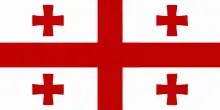 House of Bagrationi: Knight of the Grand Collar of the Order of the Eagle of Georgia
House of Bagrationi: Knight of the Grand Collar of the Order of the Eagle of Georgia
 Germany:
Germany:
.svg.png.webp) House of Wittelsbach: Knight Grand Cross with Collar of the Order of Saint Hubert
House of Wittelsbach: Knight Grand Cross with Collar of the Order of Saint Hubert House of Hanover: Knight Grand Cross with Collar of the Order of Henry the Lion
House of Hanover: Knight Grand Cross with Collar of the Order of Henry the Lion
 Greece:
Greece:
.svg.png.webp) House of Glücksburg: Collar of the Order of Saints George and Constantine
House of Glücksburg: Collar of the Order of Saints George and Constantine
.svg.png.webp) Holy See: Knight/Dame of the Collar of the Equestrian Order of the Holy Sepulchre of Jerusalem
Holy See: Knight/Dame of the Collar of the Equestrian Order of the Holy Sepulchre of Jerusalem.svg.png.webp) Holy See: Knight with the Collar of the Order of Pius IX
Holy See: Knight with the Collar of the Order of Pius IX Hungary : Hungarian Corvin Chain
Hungary : Hungarian Corvin Chain Hungary : Grand Cross with Chain of the Order of Merit of the Republic of Hungary, Civilian Class (Recipients)
Hungary : Grand Cross with Chain of the Order of Merit of the Republic of Hungary, Civilian Class (Recipients) Iceland: Collar with Grand Cross Breast Star of the Order of the Falcon *
Iceland: Collar with Grand Cross Breast Star of the Order of the Falcon * Italy: Knight Grand Cross with Collar of the Order of Merit of the Italian Republic (Recipients)
Italy: Knight Grand Cross with Collar of the Order of Merit of the Italian Republic (Recipients)
.svg.png.webp) House of Bourbon-Two Sicilies /
House of Bourbon-Two Sicilies /  House of Bourbon-Parma: Bailiff Knight Grand Cross with Collar of the Sacred Military Constantinian Order of Saint George
House of Bourbon-Parma: Bailiff Knight Grand Cross with Collar of the Sacred Military Constantinian Order of Saint George.svg.png.webp) Sovereign Military Order of Malta: Collar of the Order pro Merito Melitensi
Sovereign Military Order of Malta: Collar of the Order pro Merito Melitensi
 Latvia : Commander Grand Cross with Chain of the Order of Three Stars
Latvia : Commander Grand Cross with Chain of the Order of Three Stars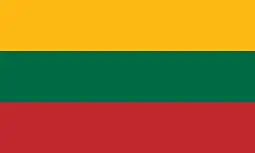 Lithuania: Golden Chain of the Order of Vytautas the Great (Recipients)
Lithuania: Golden Chain of the Order of Vytautas the Great (Recipients) Malta: Honorary Companion of Honour with Collar of the National Order of Merit
Malta: Honorary Companion of Honour with Collar of the National Order of Merit Norway: Grand Cross with Collar of the Royal Norwegian Order of St. Olav
Norway: Grand Cross with Collar of the Royal Norwegian Order of St. Olav Portugal: Grand Collar of the Order of the Tower and Sword
Portugal: Grand Collar of the Order of the Tower and Sword Portugal: Grand Collar of the Military Order of Christ
Portugal: Grand Collar of the Military Order of Christ Portugal: Grand Collar of the Military Order of Aviz
Portugal: Grand Collar of the Military Order of Aviz Portugal: Grand Collar of the Order of Saint James of the Sword (Recipients)
Portugal: Grand Collar of the Order of Saint James of the Sword (Recipients) Portugal: Grand Collar of the Order of Prince Henry (Recipients)
Portugal: Grand Collar of the Order of Prince Henry (Recipients) Portugal: Grand Collar of the Order of Liberty (Recipients)
Portugal: Grand Collar of the Order of Liberty (Recipients) Portugal: Grand Collar of the Order of Camões
Portugal: Grand Collar of the Order of Camões
.svg.png.webp) House of Braganza: Grand Collar of the Order of Saint Michael of the Wing
House of Braganza: Grand Collar of the Order of Saint Michael of the Wing.svg.png.webp) House of Braganza: Grand Collar of the Order of Merit of the Portuguese Royal House
House of Braganza: Grand Collar of the Order of Merit of the Portuguese Royal House
 Romania: Collar of the Order of the Star of Romania
Romania: Collar of the Order of the Star of Romania
 House of Hohenzollern-Sigmaringen: Grand Cross with Collar of the Order of Carol I
House of Hohenzollern-Sigmaringen: Grand Cross with Collar of the Order of Carol I
 San Marino: Collar of the Order of San Marino
San Marino: Collar of the Order of San Marino Serbia: Collar of the Order of the Republic of Serbia
Serbia: Collar of the Order of the Republic of Serbia
.svg.png.webp) House of Karađorđević: Knight Grand Collar of the Order of St. Prince Lazar
House of Karađorđević: Knight Grand Collar of the Order of St. Prince Lazar
 Spain: Knight/Dame of the Collar of the Order of Charles III
Spain: Knight/Dame of the Collar of the Order of Charles III Spain: Knight/Dame of the Collar of the Order of Civil Merit (Recipients)
Spain: Knight/Dame of the Collar of the Order of Civil Merit (Recipients) Spain: Knight/Dame of the Collar of the Order of Isabella the Catholic (Recipients)
Spain: Knight/Dame of the Collar of the Order of Isabella the Catholic (Recipients) Spain: Knight/Dame of the Collar of the Civil Order of Alfonso X, the Wise (Recipients)
Spain: Knight/Dame of the Collar of the Civil Order of Alfonso X, the Wise (Recipients) United Kingdom: Recipient of the Royal Victorian Chain
United Kingdom: Recipient of the Royal Victorian Chain
America
 Antigua and Barbuda: Knight/Dame Grand Collar of the Order of the Nation
Antigua and Barbuda: Knight/Dame Grand Collar of the Order of the Nation Argentina: Collar of the Order of the Liberator General San Martín (Recipients)
Argentina: Collar of the Order of the Liberator General San Martín (Recipients)

.svg.png.webp) Bolivia: Grand Collar of the Order of the Condor of the Andes
Bolivia: Grand Collar of the Order of the Condor of the Andes Brazil: Grand Collar of the National Order of the Southern Cross
Brazil: Grand Collar of the National Order of the Southern Cross Brazil: Grand Collar of the National Congress Order
Brazil: Grand Collar of the National Congress Order
 Minas Gerais: Grand Collar of the Medal of Inconfidência
Minas Gerais: Grand Collar of the Medal of Inconfidência
 Chile: Collar of the Order of the Merit of Chile
Chile: Collar of the Order of the Merit of Chile Chile: Collar of the Order of Bernardo O'Higgins
Chile: Collar of the Order of Bernardo O'Higgins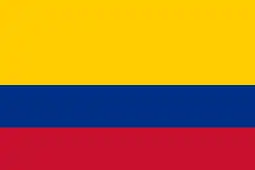 Colombia: Grand Collar of the Order of Boyacá
Colombia: Grand Collar of the Order of Boyacá Colombia: Grand Collar of the Order of San Carlos
Colombia: Grand Collar of the Order of San Carlos Dominican Republic: Collar of the Order of Merit of Duarte, Sánchez and Mella
Dominican Republic: Collar of the Order of Merit of Duarte, Sánchez and Mella Dominican Republic: Collar of the Order of Christopher Columbus
Dominican Republic: Collar of the Order of Christopher Columbus Ecuador: Grand Collar of the National Order of San Lorenzo
Ecuador: Grand Collar of the National Order of San Lorenzo Ecuador: Grand Collar of the National Order of Merit
Ecuador: Grand Collar of the National Order of Merit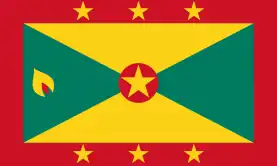 Grenada: Knight/Dame Grand Collar of the Order of Grenada
Grenada: Knight/Dame Grand Collar of the Order of Grenada Guatemala: Collar of the Order of the Quetzal
Guatemala: Collar of the Order of the Quetzal Guatemala: Collar of the Order of Antonio José de Irisarri
Guatemala: Collar of the Order of Antonio José de Irisarri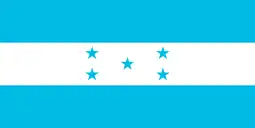 Honduras: Grand Collar of the José Cecilio del Valle Order
Honduras: Grand Collar of the José Cecilio del Valle Order Mexico: Collar of the Order of the Aztec Eagle
Mexico: Collar of the Order of the Aztec Eagle Nicaragua: Collar of the Order of Ruben Dario
Nicaragua: Collar of the Order of Ruben Dario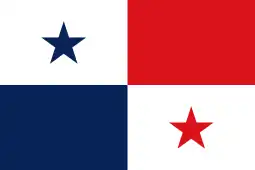 Panama: Collar of the Order of Manuel Amador Guerrero
Panama: Collar of the Order of Manuel Amador Guerrero Paraguay: Collar of the National Order of Merit
Paraguay: Collar of the National Order of Merit Peru: Grand Collar of the Order of the Sun of Peru
Peru: Grand Collar of the Order of the Sun of Peru Venezuela: Collar of the Order of the Liberator
Venezuela: Collar of the Order of the Liberator
Africa
 Egypt: Collar of the Order of the Nile
Egypt: Collar of the Order of the Nile Egypt: Collar of the Order of the Republic
Egypt: Collar of the Order of the Republic Ethiopia:
Ethiopia:
.svg.png.webp) House of Solomon: Collar of the Order of the Seal of Solomon
House of Solomon: Collar of the Order of the Seal of Solomon.svg.png.webp) House of Solomon: Collar of the Order of the Queen of Sheba
House of Solomon: Collar of the Order of the Queen of Sheba.svg.png.webp) House of Solomon: Grand Cross with Collar of the Order of the Holy Trinity
House of Solomon: Grand Cross with Collar of the Order of the Holy Trinity
 Ivory Coast: Collar of the National Order of the Ivory Coast
Ivory Coast: Collar of the National Order of the Ivory Coast Libya:
Libya:
.svg.png.webp) House of Senussi: Grand Collar of the Order of Idris I
House of Senussi: Grand Collar of the Order of Idris I
 Rwanda:
Rwanda:
.svg.png.webp) House of Ndahindurwa: Knight Grand Collar of the Royal Order of the Drum
House of Ndahindurwa: Knight Grand Collar of the Royal Order of the Drum
 Sudan: Collar of Honour
Sudan: Collar of Honour
Middle East
 Bahrain: Collar of the Order of Khalifa
Bahrain: Collar of the Order of Khalifa Jordan: Collar of the Order of al-Hussein bin Ali
Jordan: Collar of the Order of al-Hussein bin Ali Kuwait: Collar of the Order of Mubarak the Great
Kuwait: Collar of the Order of Mubarak the Great Oman: Collar of the Order of Al-Said
Oman: Collar of the Order of Al-Said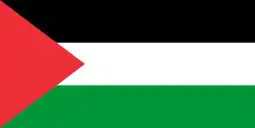 Palestine: Grand Collar of the State of Palestine
Palestine: Grand Collar of the State of Palestine Saudi Arabia : Badr Chain
Saudi Arabia : Badr Chain Saudi Arabia : Collar of the Order of Abdulaziz al Saud
Saudi Arabia : Collar of the Order of Abdulaziz al Saud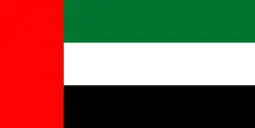 United Arab Emirates : Collar of the Order of Zayed
United Arab Emirates : Collar of the Order of Zayed
South East & North Asia
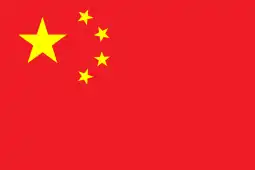 China: Friendship Medal
China: Friendship Medal
 Manchukuo: Collar of the Grand Order of the Orchid Blossom
Manchukuo: Collar of the Grand Order of the Orchid Blossom
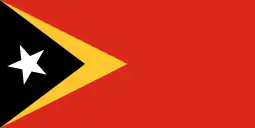 East Timor: Grand Collar of the Order of Timor-Leste
East Timor: Grand Collar of the Order of Timor-Leste Japan: Collar of the Order of the Chrysanthemum
Japan: Collar of the Order of the Chrysanthemum Laos:
Laos:
.svg.png.webp) Lao royal family: Grand Cross with Collar of the Order of the Million Elephants and the White Parasol
Lao royal family: Grand Cross with Collar of the Order of the Million Elephants and the White Parasol
 Philippines: Grand Collar (Maringal na Kuwintas) of the Order of the Golden Heart (Recipients)
Philippines: Grand Collar (Maringal na Kuwintas) of the Order of the Golden Heart (Recipients) Philippines: Grand Collar (Supremo) of the Order of Lakandula (Recipients)
Philippines: Grand Collar (Supremo) of the Order of Lakandula (Recipients) Philippines: Grand Collar (Raja) of the Order of Sikatuna
Philippines: Grand Collar (Raja) of the Order of Sikatuna South Korea: Collar of the Grand Order of Mugunghwa
South Korea: Collar of the Grand Order of Mugunghwa
Oceania
 Tonga: Knight Grand Cross with Collar of the Royal Order of Pouono
Tonga: Knight Grand Cross with Collar of the Royal Order of Pouono Tonga: Knight Grand Cross with Collar of the Order of the Crown of Tonga
Tonga: Knight Grand Cross with Collar of the Order of the Crown of Tonga Tonga: Knight Grand Cross with Collar of the Order of Queen Sālote Tupou III
Tonga: Knight Grand Cross with Collar of the Order of Queen Sālote Tupou III
* indicates that the insignia must be returned upon the death of the recipient
† indicates that the order is now dormant but has not been formally abolished
Gallery


 Grand Collar of the National Order of the Southern Cross (Brazil)
Grand Collar of the National Order of the Southern Cross (Brazil)

 Coat of arms of Frederick IV of Denmark and Norway surrounded by the collars of the Order of the Dannebrog and the Order of the Elephant
Coat of arms of Frederick IV of Denmark and Norway surrounded by the collars of the Order of the Dannebrog and the Order of the Elephant

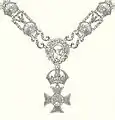


 Collar of the Order of St. Prince Lazar
Collar of the Order of St. Prince Lazar
(Kingdom of Serbia, Kingdom of Yugoslavia and Royal House of Serbia)






.svg.png.webp)

 Collar of the Order of the Sword
Collar of the Order of the Sword
(Sweden) Collar of the Order of the Polar Star
Collar of the Order of the Polar Star
(Sweden)_-_Tallinn_Museum_of_Orders.jpg.webp) Collar of the Order of Vasa
Collar of the Order of Vasa
(Sweden)
 Collar of the Order of the Garter (United Kingdom)
Collar of the Order of the Garter (United Kingdom) The Star and Collar of a Knight Grand Cross of the Order of St. Michael and St. George (United Kingdom)
The Star and Collar of a Knight Grand Cross of the Order of St. Michael and St. George (United Kingdom)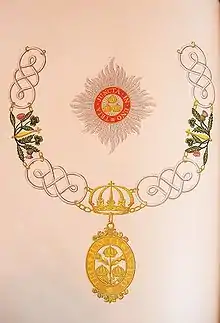 Star and Collar of a Knight Grand Cross of the civil division of the Order of the Bath
Star and Collar of a Knight Grand Cross of the civil division of the Order of the Bath
(United Kingdom and Commonwealth) Star and Collar of a Knight Grand Cross of the military division of the Order of the Bath
Star and Collar of a Knight Grand Cross of the military division of the Order of the Bath Collar of the Order of Saint Sylvester and the Golden Militia
Collar of the Order of Saint Sylvester and the Golden Militia
(Vatican)
Line drawings from Maximilian Gritzner, 1893.
References
- Syr Gawayn and the Grene Knyzt-(Concluded), J. R. Hulbert, Modern Philology, Vol. 13, No. 12 (Apr., 1916), 140.
- Evans, Joan (1989-01-01). A History of Jewellery, 1100-1870. Courier Corporation. p. 77. ISBN 978-0-486-26122-5.
- "Men's fashion". Fashions of the Hapsburg Era: Austria-Hungary. Metropolitan Museum of Art. 1979. p. 3.
- Fontenay, Eugène (1887). Les bijoux anciens et modernes (in French). Maison Quantin. p. 189.
- Boulton d'Arcy, Jonathan Dacre (2000). The Knights of the Crown: The Monarchical Orders of Knighthood in Later Medieval Europe, 1325-1520. Boydell Press. p. 442. ISBN 978-0-85115-795-5.
- Chaffanjon, Arnaud (1969). Les grands ordres de Chevalerie (in French). S.E.R.G. p. 117.
- Bonfait, Olivier; Desmas, Anne-Lise; Marin, Brigitte (2003). Les portraits du pouvoir: actes du colloque (in French). Somogy. p. 231. ISBN 978-2-85056-608-0.
- Arnoul, François (1647). Institution de l'Ordre du Collier Céleste du Sacré Rosaire (in French). Paris & Lyon: Jacques Carteron.
- Ashmole, Elias (1672). "7. The Habit and Ensigns of the Order". The Institution, Laws and Ceremonies of the Most Noble Order of the Garter. J. Macock. p. 222.


